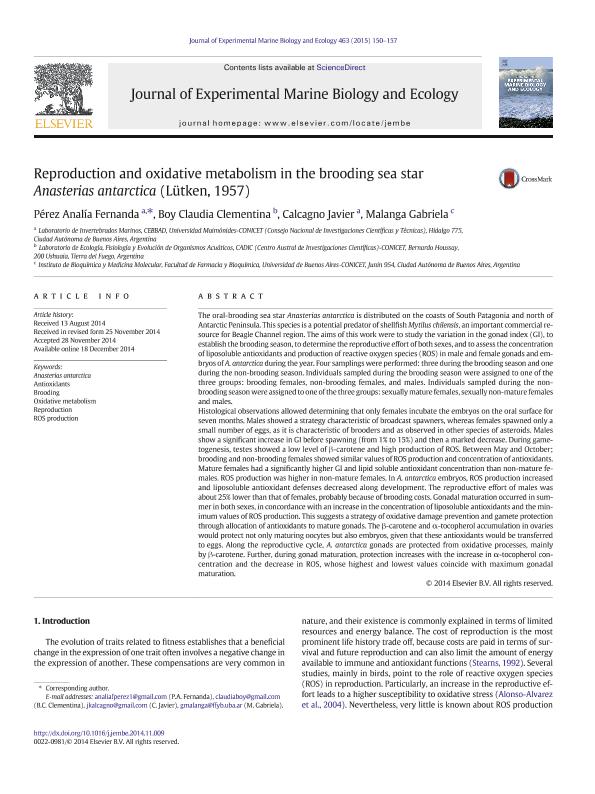Mostrar el registro sencillo del ítem
dc.contributor.author
Perez, Analia Fernanda

dc.contributor.author
Boy, Claudia Clementina

dc.contributor.author
Calcagno, Javier Angel

dc.contributor.author
Malanga, Gabriela Fabiana

dc.date.available
2016-04-15T21:46:33Z
dc.date.issued
2015-01
dc.identifier.citation
Perez, Analia Fernanda; Boy, Claudia Clementina; Calcagno, Javier Angel; Malanga, Gabriela Fabiana; Reproduction and oxidative metabolism in the brooding sea star Anasterias antarctica (Lütken, 1957); Elsevier; Journal of Experimental Marine Biology and Ecology; 453; 1-2015; 150-157
dc.identifier.issn
0022-0981
dc.identifier.uri
http://hdl.handle.net/11336/5248
dc.description.abstract
The oral-brooding sea star Anasterias antarctica is distributed on the coasts of South Patagonia and north of Antarctic Peninsula. This species is a potential predator of shellfish Mytilus chilensis, an important commercial resource for Beagle Channel region. The aims of this work were to study the variation in the gonad index (GI), to establish the brooding season, to determine the reproductive effort of both sexes, and to assess the concentration of liposoluble antioxidants and production of reactive oxygen species (ROS) in male and female gonads and embryos of A. antarctica during the year. Four samplingswere performed: three during the brooding season and one during the non-brooding season. Individuals sampled during the brooding season were assigned to one of the three groups: brooding females, non-brooding females, and males. Individuals sampled during the nonbrooding seasonwere assigned to one of the three groups: sexuallymature females, sexually non-mature females and males. Histological observations allowed determining that only females incubate the embryos on the oral surface for seven months. Males showed a strategy characteristic of broadcast spawners, whereas females spawned only a small number of eggs, as it is characteristic of brooders and as observed in other species of asteroids. Males show a significant increase in GI before spawning (from 1% to 15%) and then a marked decrease. During gametogenesis, testes showed a low level of β-carotene and high production of ROS. Between May and October; brooding and non-brooding females showed similar values of ROS production and concentration of antioxidants. Mature females had a significantly higher GI and lipid soluble antioxidant concentration than non-mature females. ROS production was higher in non-mature females. In A. antarctica embryos, ROS production increased and liposoluble antioxidant defenses decreased along development. The reproductive effort of males was about 25% lower than that of females, probably because of brooding costs. Gonadal maturation occurred in summer in both sexes, in concordance with an increase in the concentration of liposoluble antioxidants and the minimum values of ROS production. This suggests a strategy of oxidative damage prevention and gamete protection through allocation of antioxidants to mature gonads. The β-carotene and α-tocopherol accumulation in ovaries would protect not only maturing oocytes but also embryos, given that these antioxidants would be transferred to eggs. Along the reproductive cycle, A. antarctica gonads are protected from oxidative processes, mainly by β-carotene. Further, during gonad maturation, protection increases with the increase in α-tocopherol concentration and the decrease in ROS, whose highest and lowest values coincide with maximum gonadal maturation.
dc.format
application/pdf
dc.language.iso
eng
dc.publisher
Elsevier

dc.rights
info:eu-repo/semantics/openAccess
dc.rights.uri
https://creativecommons.org/licenses/by-nc-nd/2.5/ar/
dc.subject
Anasterias Antarctica
dc.subject
Antioxidants
dc.subject
Brooding
dc.subject
Oxidative Metabolism
dc.subject
Reproduction
dc.subject
Ros Production
dc.subject.classification
Biología Reproductiva

dc.subject.classification
Ciencias Biológicas

dc.subject.classification
CIENCIAS NATURALES Y EXACTAS

dc.title
Reproduction and oxidative metabolism in the brooding sea star Anasterias antarctica (Lütken, 1957)
dc.type
info:eu-repo/semantics/article
dc.type
info:ar-repo/semantics/artículo
dc.type
info:eu-repo/semantics/publishedVersion
dc.date.updated
2016-05-06 15:52:43.262787-03
dc.journal.volume
453
dc.journal.pagination
150-157
dc.journal.pais
Países Bajos

dc.journal.ciudad
Amsterdam
dc.description.fil
Fil: Perez, Analia Fernanda. Universidad Maimónides. Area de Investigaciones Biomédicas y Biotecnológicas. Centro de Estudios Biomédicos, Biotecnológicos, Ambientales y de Diagnóstico; Argentina
dc.description.fil
Fil: Boy, Claudia Clementina. Consejo Nacional de Investigaciones Científicas y Técnicas. Centro Austral de Investigaciones Científicas; Argentina
dc.description.fil
Fil: Calcagno, Javier Angel. Universidad Maimónides. Area de Investigaciones Biomédicas y Biotecnológicas. Centro de Estudios Biomédicos, Biotecnológicos, Ambientales y de Diagnóstico; Argentina
dc.description.fil
Fil: Malanga, Gabriela Fabiana. Consejo Nacional de Investigaciones Científicas y Técnicas. Oficina de Coordinación Administrativa Houssay. Instituto de Bioquímica y Medicina Molecular; Argentina
dc.journal.title
Journal of Experimental Marine Biology and Ecology

dc.relation.alternativeid
info:eu-repo/semantics/altIdentifier/url/http://www.sciencedirect.com/science/article/pii/S0022098114003116
dc.relation.alternativeid
info:eu-repo/semantics/altIdentifier/doi/http://dx.doi.org/10.1016/j.jembe.2014.11.009
dc.relation.alternativeid
info:eu-repo/semantics/altIdentifier/doi/10.1016/j.jembe.2014.11.009
Archivos asociados
